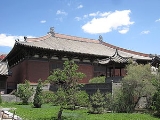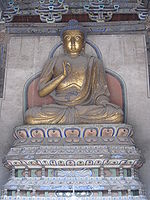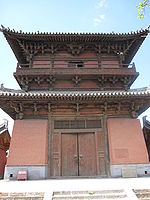
Shanhua Temple
Encyclopedia
Shanhua Temple is a Buddhist temple
located in Datong
, Shanxi Province, China
. The temple was first founded during the early 8th century of the Tang Dynasty
, but its earliest surviving building dates from the 11th century. The temple was heavily repaired over the years, and today three original halls and two recently rebuilt pavilions survive. The largest, and earliest hall, dating from the 11th-century Liao Dynasty
, is the Daxiongbao Hall, and is one of the largest of its kind in China. Also historically significant are the Main Gate and Sansheng Hall, both dating from 12th century during the Jin Dynasty.
(713-741) under the patronage of emperor Xuanzong
, at which time it was known as the Kaiyuan Temple. After the fall of the Tang Dynasty during the Five Dynasties period (906-960), the temple underwent a name change and was known as Da Pu’ensi. During this chaotic time, out of ten buildings at the temple, only three or four escaped destruction. After the takeover by the Liao Dynasty
in 960, the temple assumed its present configuration.
The temple was again heavily damaged when the Jin Dynasty took over in 1120, and in 1128 repair work was started that took fifteen years to complete. In 1421, more repairs were undertaken, this time by a monk named Dayong. In 1445, he received an imperial presentation of sutras
. This is also the first time that the temple was referred to by its present name, Shanhua Temple. In the late 16th century, drum and bell towers were built on the same stone platform (yuetai, 月台) supporting the Daxiongbao Hall. Further repairs were made to the temple over the next two hundred years but by the late 18th century the temple was once again in a state of disrepair, and the use of one of the halls as a camel
stable had caused a wall to collapse. During World War II
, the Puxian pavilion was destroyed, and was rebuilt in 1953.
(907-1125), but only the Mahavira Hall is now considered a Liao Building. The Main Gate and Sansheng Hall were extensively renovated during the subsequent Jin Dynasty, and are classified by scholars as being Jin buildings.
 The Daxiongbao Hall is the northernmost and largest hall, and dates from the 11th century. It measures seven by five bays (40.5 by 25 m) and has three doors at the front of the hall. The hall is built on an elevated three meter high platform that was once the site of both a drum and bell tower that are no longer extant. According to the standards in the 11th century Chinese architectural treatise Yingzao Fashi
The Daxiongbao Hall is the northernmost and largest hall, and dates from the 11th century. It measures seven by five bays (40.5 by 25 m) and has three doors at the front of the hall. The hall is built on an elevated three meter high platform that was once the site of both a drum and bell tower that are no longer extant. According to the standards in the 11th century Chinese architectural treatise Yingzao Fashi
, the hall is held up by fifth rank bracket sets (鋪作) in a system of eight ranks. The interior contains four large Buddha statues representing the four cardinal directions, and a central statue representing Sakyamuni. The statues are similar, and represent the Buddha displaying different mudra
s (symbolic hand gestures). Above the Sakyamuni statue, is a caisson
, an octagonal wooden ceiling that is painted and decorated.
Along with other statues of disciples and attendants grouped with the large statues, there are also 24 deva
statues located next to the east and west walls. There are 190 square meters of murals in the hall. They date from 1708 to 1716, but have been damaged over the years.
(the universal aspect of Shakyamuni) and two accompanying statues of Manjusri
and Samantabhadra
. The hall has very few central pillars for its support and depends on complex rafters and brackets of the 6th rank for its support.
 The Puxian Pavilion was initially built during the Liao Dynasty, and was examined by Liang Sicheng
The Puxian Pavilion was initially built during the Liao Dynasty, and was examined by Liang Sicheng
in the 1930s. He reported a heavily damaged structure with two stories. On the first story was a miniature building and niche with two images. On the top story was a statue of the Bodhisattva Samantabhadra
.
The building was rebuilt in 1953 after having been destroyed during the war. The pavilion measures three bays by two, but is nearly a perfect square. It is built on a short stone platform called a yuetai (月台) which is accessed by a short set of stairs. While from the outside, the pavilion appears to only have two stories, there are actually three, with the second floor being hidden from outside view. Each of the exterior levels is surrounded by a perimeter of columns.
. It was rebuilt in 2008 by the local government.
, with two on the east side, and two on the west side. It is five bays
long, and two bays wide and has an area of 278 square meters. The brackets
used to support the structure are of the 5th rank.
Temple
A temple is a structure reserved for religious or spiritual activities, such as prayer and sacrifice, or analogous rites. A templum constituted a sacred precinct as defined by a priest, or augur. It has the same root as the word "template," a plan in preparation of the building that was marked out...
located in Datong
Datong
Datong is a prefecture-level city in northern Shanxi Province of North China, located a few hundred kilometres west by rail from Beijing with an elevation of...
, Shanxi Province, China
China
Chinese civilization may refer to:* China for more general discussion of the country.* Chinese culture* Greater China, the transnational community of ethnic Chinese.* History of China* Sinosphere, the area historically affected by Chinese culture...
. The temple was first founded during the early 8th century of the Tang Dynasty
Tang Dynasty
The Tang Dynasty was an imperial dynasty of China preceded by the Sui Dynasty and followed by the Five Dynasties and Ten Kingdoms Period. It was founded by the Li family, who seized power during the decline and collapse of the Sui Empire...
, but its earliest surviving building dates from the 11th century. The temple was heavily repaired over the years, and today three original halls and two recently rebuilt pavilions survive. The largest, and earliest hall, dating from the 11th-century Liao Dynasty
Liao Dynasty
The Liao Dynasty , also known as the Khitan Empire was an empire in East Asia that ruled over the regions of Manchuria, Mongolia, and parts of northern China proper between 9071125...
, is the Daxiongbao Hall, and is one of the largest of its kind in China. Also historically significant are the Main Gate and Sansheng Hall, both dating from 12th century during the Jin Dynasty.
History
The Shanhua Temple was first founded during the Kaiyuan period of the Tang DynastyTang Dynasty
The Tang Dynasty was an imperial dynasty of China preceded by the Sui Dynasty and followed by the Five Dynasties and Ten Kingdoms Period. It was founded by the Li family, who seized power during the decline and collapse of the Sui Empire...
(713-741) under the patronage of emperor Xuanzong
Xuanzong
Xuanzong can be the name of the following Chinese emperors:* Emperor Xuánzong of Tang * Emperor Xuānzong of Tang...
, at which time it was known as the Kaiyuan Temple. After the fall of the Tang Dynasty during the Five Dynasties period (906-960), the temple underwent a name change and was known as Da Pu’ensi. During this chaotic time, out of ten buildings at the temple, only three or four escaped destruction. After the takeover by the Liao Dynasty
Liao Dynasty
The Liao Dynasty , also known as the Khitan Empire was an empire in East Asia that ruled over the regions of Manchuria, Mongolia, and parts of northern China proper between 9071125...
in 960, the temple assumed its present configuration.
The temple was again heavily damaged when the Jin Dynasty took over in 1120, and in 1128 repair work was started that took fifteen years to complete. In 1421, more repairs were undertaken, this time by a monk named Dayong. In 1445, he received an imperial presentation of sutras
Sutra
Sūtra is an aphorism or a collection of such aphorisms in the form of a manual. Literally it means a thread or line that holds things together and is derived from the verbal root siv-, meaning to sew , as does the medical term...
. This is also the first time that the temple was referred to by its present name, Shanhua Temple. In the late 16th century, drum and bell towers were built on the same stone platform (yuetai, 月台) supporting the Daxiongbao Hall. Further repairs were made to the temple over the next two hundred years but by the late 18th century the temple was once again in a state of disrepair, and the use of one of the halls as a camel
Camel
A camel is an even-toed ungulate within the genus Camelus, bearing distinctive fatty deposits known as humps on its back. There are two species of camels: the dromedary or Arabian camel has a single hump, and the bactrian has two humps. Dromedaries are native to the dry desert areas of West Asia,...
stable had caused a wall to collapse. During World War II
World War II
World War II, or the Second World War , was a global conflict lasting from 1939 to 1945, involving most of the world's nations—including all of the great powers—eventually forming two opposing military alliances: the Allies and the Axis...
, the Puxian pavilion was destroyed, and was rebuilt in 1953.
Architecture
The Shanhua Temple today consists of three main halls (The Daxiongbao Hall, the Sansheng Hall and the Main Gate) arranged on a north-south axis and two pavilions located to the east and west of the Sansheng Hall. There are also two smaller halls on each side of the Daxiongbao Hall. The main halls were all first built during the Liao DynastyLiao Dynasty
The Liao Dynasty , also known as the Khitan Empire was an empire in East Asia that ruled over the regions of Manchuria, Mongolia, and parts of northern China proper between 9071125...
(907-1125), but only the Mahavira Hall is now considered a Liao Building. The Main Gate and Sansheng Hall were extensively renovated during the subsequent Jin Dynasty, and are classified by scholars as being Jin buildings.
Daxiongbao Hall

Yingzao Fashi
The Yingzao Fashi is a technical treatise on architecture and craftsmanship written by the Chinese author Li Jie , the Directorate of Buildings and Construction during the mid Song Dynasty of China. A promising architect, he revised many older treatises on architecture from 1097 to 1100...
, the hall is held up by fifth rank bracket sets (鋪作) in a system of eight ranks. The interior contains four large Buddha statues representing the four cardinal directions, and a central statue representing Sakyamuni. The statues are similar, and represent the Buddha displaying different mudra
Mudra
A mudrā is a symbolic or ritual gesture in Hinduism and Buddhism. While some mudrās involve the entire body, most are performed with the hands and fingers...
s (symbolic hand gestures). Above the Sakyamuni statue, is a caisson
Caisson (Asian architecture)
The Caisson , also referred to as a caisson ceiling, or spider web ceiling, in East Asian architecture is an architectural feature typically found in the ceiling of temples and palaces, usually at the centre and directly above the main throne, seat, or religious figure.The caisson is generally a...
, an octagonal wooden ceiling that is painted and decorated.
Along with other statues of disciples and attendants grouped with the large statues, there are also 24 deva
Deva (Buddhism)
A deva in Buddhism is one of many different types of non-human beings who share the characteristics of being more powerful, longer-lived, and, in general, living more contentedly than the average human being....
statues located next to the east and west walls. There are 190 square meters of murals in the hall. They date from 1708 to 1716, but have been damaged over the years.
Sansheng Hall
The Sansheng Hall is the middle hall, and was built during the Jin Dynasty. It houses statues of the three sages of the Avatamsaka Sutra - a central one of VairocanaVairocana
Vairocana is a celestial Buddha who is often interpreted as the Bliss Body of the historical Gautama Buddha; he can also be referred to as the dharmakaya Buddha and the great solar Buddha. In Sino-Japanese Buddhism, Vairocana is also seen as the embodiment of the Buddhist concept of shunyata or...
(the universal aspect of Shakyamuni) and two accompanying statues of Manjusri
Manjusri
Mañjuśrī is a bodhisattva associated with transcendent wisdom in Mahāyāna Buddhism. In Esoteric Buddhism he is also taken as a meditational deity. The Sanskrit name Mañjuśrī can be translated as "Gentle Glory"...
and Samantabhadra
Samantabhadra
Samantabhadra , is a bodhisattva in Mahayana Buddhism associated with Buddhist practice and meditation. Together with Shakyamuni Buddha and fellow bodhisattva Manjusri he forms the Shakyamuni trinity in Buddhism...
. The hall has very few central pillars for its support and depends on complex rafters and brackets of the 6th rank for its support.
Puxian Pavilion

Liang Sicheng
Liang Sicheng was the son of Liang Qichao, a well-known Chinese thinker in the late Qing Dynasty. Liang Sicheng returned to China from the United States after studying at the University of Pennsylvania...
in the 1930s. He reported a heavily damaged structure with two stories. On the first story was a miniature building and niche with two images. On the top story was a statue of the Bodhisattva Samantabhadra
Samantabhadra
Samantabhadra , is a bodhisattva in Mahayana Buddhism associated with Buddhist practice and meditation. Together with Shakyamuni Buddha and fellow bodhisattva Manjusri he forms the Shakyamuni trinity in Buddhism...
.
The building was rebuilt in 1953 after having been destroyed during the war. The pavilion measures three bays by two, but is nearly a perfect square. It is built on a short stone platform called a yuetai (月台) which is accessed by a short set of stairs. While from the outside, the pavilion appears to only have two stories, there are actually three, with the second floor being hidden from outside view. Each of the exterior levels is surrounded by a perimeter of columns.
Wenshu Pavilion
This pavilion was destroyed in the early 20th century after it caught fire after being converted into a tanneryTanning
Tanning is the making of leather from the skins of animals which does not easily decompose. Traditionally, tanning used tannin, an acidic chemical compound from which the tanning process draws its name . Coloring may occur during tanning...
. It was rebuilt in 2008 by the local government.
Main Gate
The Main Gate is a large hall that was built during the Jin dynasty in the 12th century, and is the entrance building of the temple. The hall contains statues of the four heavenly kingsFour Heavenly Kings
In the Buddhist faith, the Four Heavenly Kings are four gods, each of whom watches over one cardinal direction of the world.The Kings are collectively named as follows:...
, with two on the east side, and two on the west side. It is five bays
Bay (architecture)
A bay is a unit of form in architecture. This unit is defined as the zone between the outer edges of an engaged column, pilaster, or post; or within a window frame, doorframe, or vertical 'bas relief' wall form.-Defining elements:...
long, and two bays wide and has an area of 278 square meters. The brackets
Bracket (architecture)
A bracket is an architectural member made of wood, stone, or metal that overhangs a wall to support or carry weight. It may also support a statue, the spring of an arch, a beam, or a shelf. Brackets are often in the form of scrolls, and can be carved, cast, or molded. They can be entirely...
used to support the structure are of the 5th rank.

